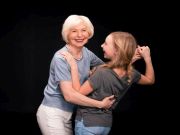THURSDAY, Oct. 1, 2020 (HealthDay News) — Preventing falls in older age could be as fun as dancing them away, new research shows.
Researchers found a 31% reduction in falls and a 37% reduction in fall risk for those aged 65 and older when reviewing clinical trials on “dance-based mind-motor activities” from around the world.
“We were positively surprised by the consistency of our results,” said study author Michèle Mattle, a movement scientist and doctoral candidate at the University of Zurich, in Switzerland.
“Although previous research in the field of falls prevention and exercise was suggesting that interventions, including multitasking activities, are promising falls-prevention strategies, it was unclear if dance-based mind-motor activities would lead to comparable results,” she said.
Dance-based mind-motor activities are those that have upright movements that emphasize balance and use music or an inner rhythm, such as breathing, according to the study. They include instructions or choreography, as well as social interaction. Tai chi meets those criteria, in addition to a variety of dance-based activities, including ballroom and folk dancing.
Though dance was often suggested as a good fall-prevention activity for older adults, there was not previously evidence for that, Mattle said. The review only found an association between dance and mobility, balance and lower body strength, not a cause-and-effect relationship. It also concluded there is a need for more high-quality trials on dance.
Tai chi is an activity that has been studied more often, but it’s not as popular in Europe, Mattle said, where many people engage in ballroom and folk dances. The 29 trials reviewed in the study were from many countries on several different continents. They included trials from the United States and Canada, as well as countries throughout Asia, Europe and South America.
“Our findings now lay an important base for the further development of public health strategies in the field of falls prevention that are accessible for cultures that are not familiar with tai chi but have a cultural bond toward different dance styles,” Mattle said.
Impaired balance and gait are important risk factors for falls in older adults, Mattle explained. The ability to multitask with two movements at once, such as talking while walking, can diminish with age. Many falls happen during walking when something unexpected happens and the person needs to react quickly, Mattle said. Balance training helps a person react faster when losing control.
“The movements in dance-based mind-motor [activities] are intentional, focused and involve the constant attention control for the shifting of body weight,” Mattle said, calling it good training for keeping dynamic balance in unexpected situations and for enhancing reaction time.
The findings were published online Sept. 25 in JAMA Network Open.
Falls are the leading cause of accidental death and injury in people over 65, said Dr. Allison Mays, a geriatrician and assistant professor of medicine at Cedars Sinai, in Southern California. Mays is involved in another study that looks at the impact of exercise classes on older adults.
Causes of falls can range from reaction time slowed by aging, vision changes that affect balance, blood pressure changes and medication, Mays said.
“Falls are not normal, even in older adults,” Mays said. “It always should deserve a conversation with your physician.”
In addition to death and injury, falls can increase fear of future falls, which can cause a person to limit activities. The number one change an older person can make to prevent falls is exercise, Mays said.
Walking is a good activity for those who are just starting to be regularly physically active, Mays said. A person’s doctor can suggest other exercise classes designed for seniors that are still available even in the time of COVID-19 on YouTube or Zoom.
Both the type of exercise and consistency matter, Mays said. To prevent falls, a class should challenge a person’s balance and require shifting weight. In the trials reviewed in this study, they saw a good degree of adherence, Mays noted, with people attending their classes 80% of the time. Having something that’s both healthy and fun makes a difference, she said.
Though tai chi has a strong base of evidence for use in falls prevention, it’s a great idea to build evidence around other physical activities, Mays suggested.
“Not everyone wants to do a traditional exercise class, and so if you can get benefits from flamenco, then that’s wonderful. It provides more options, more evidence behind different activities that are going to benefit our patients,” Mays said. “I was very pleased to see that we’re building evidence around dance and other fun activities as a way to help older adults prevent falls.”
More information
The U.S. National Institutes of Health has more on preventing falls.
Copyright © 2025 HealthDay. All rights reserved.

